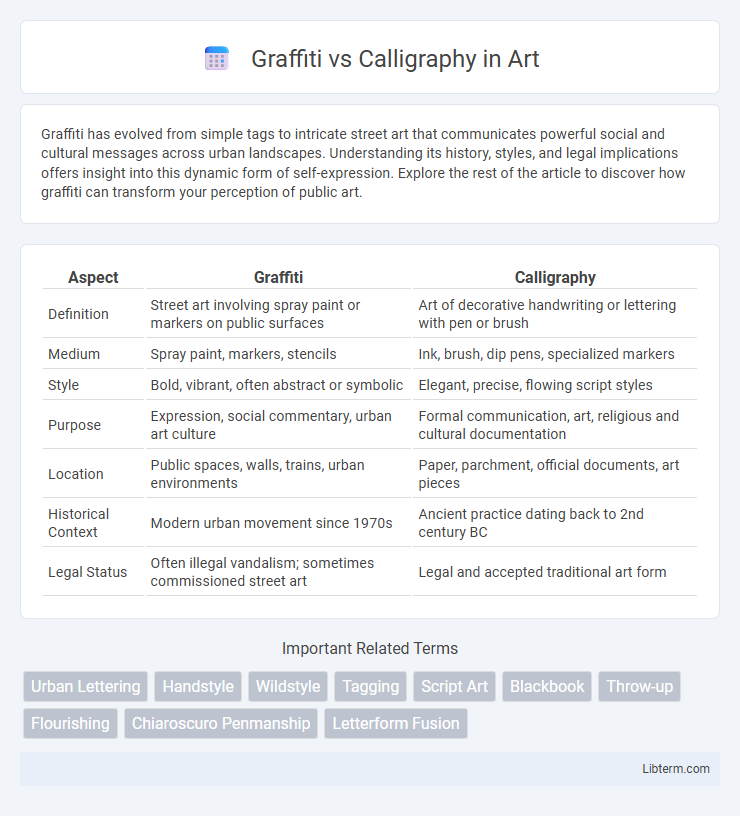Graffiti has evolved from simple tags to intricate street art that communicates powerful social and cultural messages across urban landscapes. Understanding its history, styles, and legal implications offers insight into this dynamic form of self-expression. Explore the rest of the article to discover how graffiti can transform your perception of public art.
Table of Comparison
| Aspect | Graffiti | Calligraphy |
|---|---|---|
| Definition | Street art involving spray paint or markers on public surfaces | Art of decorative handwriting or lettering with pen or brush |
| Medium | Spray paint, markers, stencils | Ink, brush, dip pens, specialized markers |
| Style | Bold, vibrant, often abstract or symbolic | Elegant, precise, flowing script styles |
| Purpose | Expression, social commentary, urban art culture | Formal communication, art, religious and cultural documentation |
| Location | Public spaces, walls, trains, urban environments | Paper, parchment, official documents, art pieces |
| Historical Context | Modern urban movement since 1970s | Ancient practice dating back to 2nd century BC |
| Legal Status | Often illegal vandalism; sometimes commissioned street art | Legal and accepted traditional art form |
Introduction: Defining Graffiti and Calligraphy
Graffiti is an urban art form characterized by stylized spray-painted or marker-drawn images and letters often found on public surfaces. Calligraphy is the traditional art of decorative handwriting or lettering using specialized pens or brushes to create elegant, flowing scripts. Both practices emphasize visual expression but differ significantly in technique, tools, and cultural context.
Historical Roots and Evolution
Graffiti traces its origins to ancient civilizations like Egypt and Rome, where public inscriptions and markings served social or political purposes, evolving into modern street art with subversive and expressive intent during the late 20th century. Calligraphy, rooted in ancient scripts such as Chinese oracle bones and Islamic Kufic script, has evolved into a formalized art focused on beauty and spirituality, particularly flourishing through religious manuscripts during the medieval era. Both forms have transformed from their historical contexts--graffiti from rebellious public markings to recognized art, calligraphy from sacred writing to contemporary artistic expression--reflecting distinct cultural evolutions.
Cultural Significance and Social Impact
Graffiti and calligraphy both serve as powerful forms of artistic expression that convey cultural identity and social messages, yet they differ significantly in context and perception. Graffiti often emerges from urban environments as a form of resistance or social commentary, highlighting issues such as inequality and identity within marginalized communities. Calligraphy, rooted in historical and religious traditions, preserves cultural heritage and fosters a sense of spiritual connection and aesthetic refinement.
Artistic Techniques and Tools
Graffiti employs spray paint, markers, and stencils to create bold, vibrant images often characterized by dynamic lines and layering techniques on urban surfaces. Calligraphy relies on specialized tools like dip pens, brushes, and ink to produce precise, flowing strokes that emphasize control and rhythm in letterforms. Both art forms explore expression through line quality and composition, yet graffiti favors improvisation and scale while calligraphy prioritizes meticulous craftsmanship and tradition.
Styles and Visual Aesthetics
Graffiti features bold, vibrant colors, dynamic shapes, and often incorporates urban motifs, creating a visually striking and rebellious aesthetic. Calligraphy emphasizes elegant, flowing lines and precise strokes, showcasing traditional craftsmanship and artistic discipline. The contrasting styles highlight graffiti's spontaneous, expressive nature against calligraphy's structured, refined visual harmony.
Legal Status and Public Perception
Graffiti often faces legal restrictions due to its association with vandalism and unauthorized public markings, leading to fines or criminal charges in many jurisdictions. Calligraphy, generally recognized as a traditional art form, enjoys greater legal protection and social acceptance, frequently displayed in galleries and cultural events. Public perception distinguishes graffiti as rebellious or subversive, while calligraphy is viewed as elegant and refined, influencing their respective treatment under the law.
Famous Artists and Influential Figures
Keith Haring and Banksy are iconic figures in the graffiti world, known for their impactful street art and social commentary, while calligraphy boasts legendary artists like Wang Xizhi and Edward Johnston, who greatly influenced traditional and modern writing styles. Jean-Michel Basquiat bridged graffiti and fine art, gaining global recognition for his expressive works rooted in street culture. Contemporary calligraphers such as Sheila Waters continue to evolve the art form, blending classical techniques with innovative designs that inspire new generations.
Modern Adaptations and Fusion Art
Modern adaptations of graffiti and calligraphy blend street art's bold, dynamic forms with calligraphy's intricate, elegant strokes, creating a unique visual language that resonates across urban and digital landscapes. Artists leverage digital tools and mixed media to fuse graffiti's vibrant colors and spontaneous expression with calligraphic precision, producing innovative works in murals, graphic design, and tattoo art. This fusion art challenges traditional boundaries, reflecting contemporary culture's diversity and expanding the possibilities within both art forms.
Influence in Urban and Traditional Spaces
Graffiti shapes urban environments by transforming public spaces into vibrant, expressive canvases that reflect contemporary culture and social issues. Calligraphy preserves traditional aesthetics through meticulously crafted lettering, often displayed in formal or ceremonial contexts that honor heritage and history. The dynamic interplay between graffiti's rebellious spontaneity and calligraphy's disciplined elegance highlights the evolving dialogue between modern urban creativity and time-honored artistic traditions.
Graffiti vs Calligraphy: Bridging Expression and Art
Graffiti and calligraphy both serve as powerful mediums of self-expression, merging visual art with cultural narratives. Graffiti, rooted in urban environments, emphasizes spontaneity and bold street aesthetics while calligraphy highlights precision and ornamental letterforms through traditional techniques. Bridging these art forms reveals a dynamic dialogue where contemporary boldness intersects with classic elegance, enriching modern artistic expression.
Graffiti Infographic

 libterm.com
libterm.com